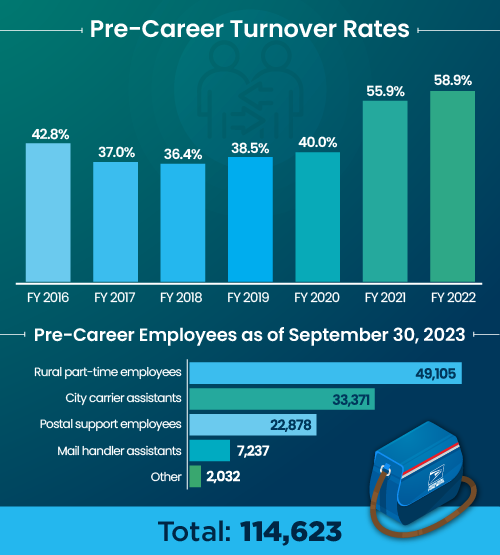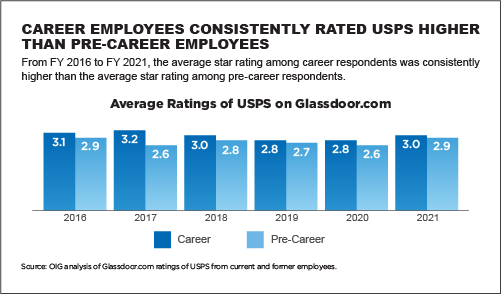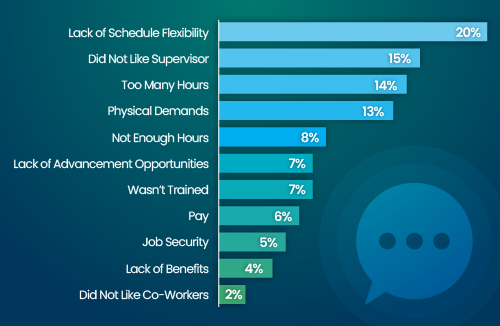
The Postal Service’s operations depend on its 640,000 employees. Nearly 115,000 are pre-career employees (formerly called non-career employees).
Pre-career employees do not receive the same level of benefits as career employees. They work as city carrier assistants (CCAs), rural career associates (RCAs), and other rural part-time employees who deliver mail; mail handler assistants (MHAs) who load, unload, and move mail in plants; postal support employees (PSEs) who perform clerical and administrative duties to support various functions; and in other roles.
Building a “stable and empowered workforce” was one of the key strategies of the Postal Service’s 2021 Delivering for America (DFA) plan. This included a goal to cut pre-career turnover by more than half. The turnover rate measures the number of pre-career employees who left the Postal Service compared to the number of pre-career employees still employed. To help achieve its strategy, USPS also pursued converting some pre-career employees to career employees. In FY 2023, more than 56,000 employees were converted.
The OIG has conducted a series of audits examining pre-career turnover over time. Our December 2016 report found that opportunities existed to improve the turnover rate. In interviews and exit surveys, pre-career employees expressed concerns about the lack of schedule flexibility, the physical demands of the job, their relationships with supervisors, and the lack of training. Had the Postal Service met its annual turnover goal by reducing the turnover rate by 8 percentage points, it would have saved $23 million per year in onboarding costs.
In February 2020, we released another audit report that took a further look at the effectiveness of the Postal Service’s efforts to reduce pre-career turnover. We found that despite a decline in turnover from fiscal year (FY) 2016, the Postal Service missed meeting its turnover goals each of the subsequent four years. While Postal Service headquarters had developed individual strategies to improve retention, we found on our site visits that these were not implemented consistently. There was also no single comprehensive national strategic plan for recruiting, hiring, and retaining pre-career employees.
Our October 2021 white paper examined how employees evaluated the Postal Service on job-related websites. USPS had lower ratings than comparable employers, but career employees consistently rated the Postal Service better than pre-career employees. Pre-career employees also consistently gave more one- and two-star reviews than four-and five-star reviews.

Because pre-career employees make up one-sixth of Postal Service employees and pre-career turnover can affect service performance for customers, we revisited our earlier audit work in an April 2023 follow-up audit. The Postal Service switched its pre-career performance goal from turnover to retention, the percentage of pre-career employees still employed with the Postal Service after 360 days. Retention was fairly stable, although fewer than half of pre-career employees stayed for a full 360 days. The turnover rate, however, grew during the pandemic, suggesting many employees were trying pre-career positions and then leaving. The three most frequent reasons for leaving were lack of schedule flexibility, not liking the supervisor, and working too many hours (see chart below).

(October 2018 - June 2022)
We reviewed the Postal Service’s programs to improve retention, including a national initiative to improve the employee experience in the first 90 days. This initiative limited workhours in the first 30 days, ensuring to the extent possible that pre-career employees worked only 40 hours per week and had at least one day off per week. It also required supervisors to hold scheduled discussions and evaluations with pre-career staff. We found, however, that long hours remained a problem after the first 30 days and supervisors did not always provide or properly document pre-career employee evaluations.
The Postal Service also tried two CCA pilots with NALC. One, which provided some limits on workhours and workdays beyond the first 30 days, was particularly successful and improved retention by 11 percentage points. We recommended the Postal Service evaluate options for workhour and workday limits, develop programs for other types of pre-career employees, and improve the use of employee evaluations.
Reducing pre-career turnover continues to be part of the Postal Service’s strategies. Ensuring adequate staffing is critical to enable the Postal Service to successfully serve the public. As the Postal Service pursues its efforts to improve retention for pre-career employees, we will continue to follow this issue.
